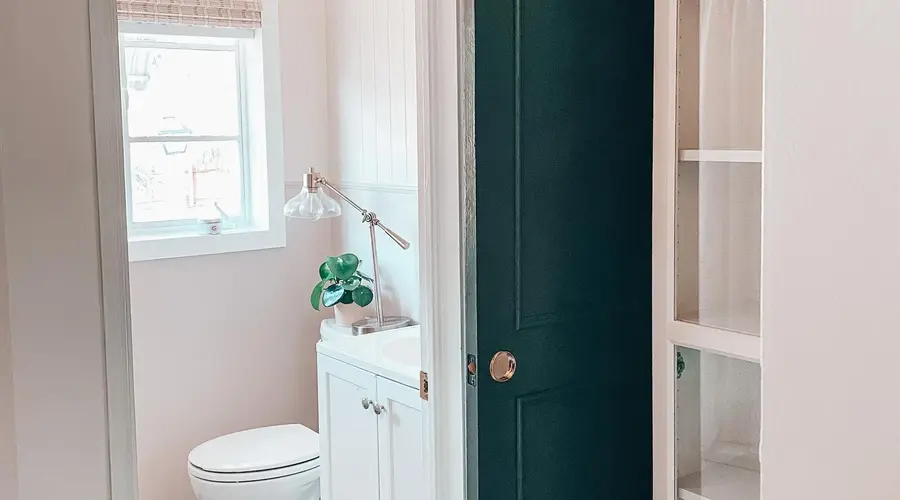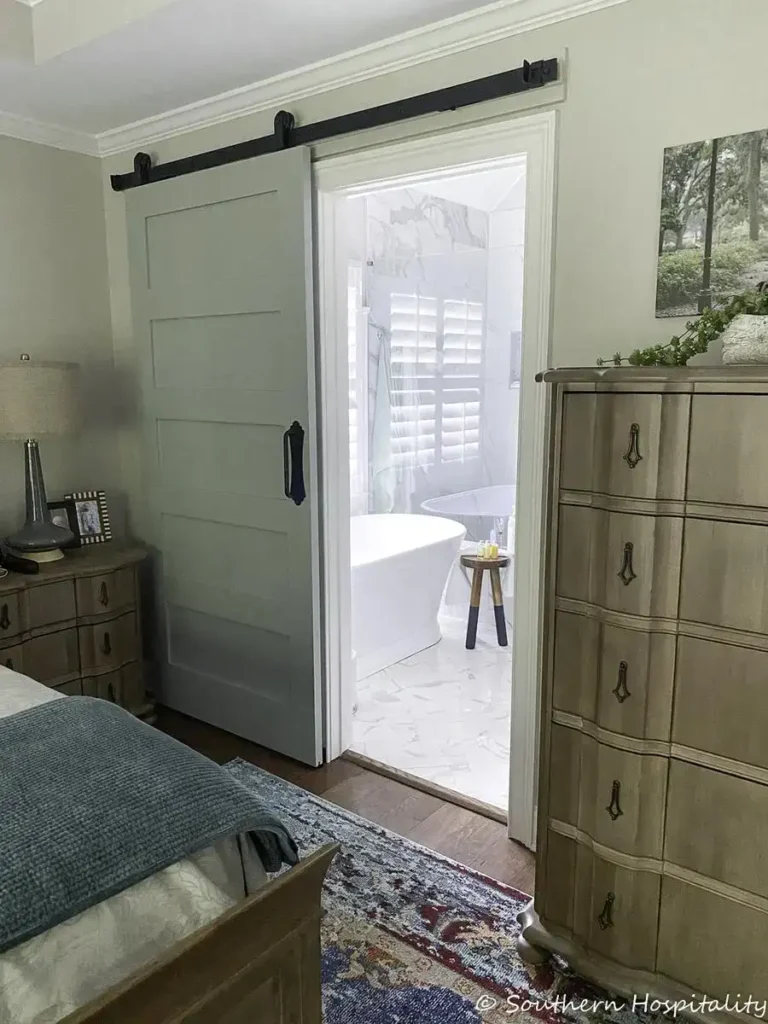Are you cramped with the small space in your bathroom? Does swinging a door feel like playing Jenga with your shower curtain? Fear not, fellow space-challenged friend! Small-space bathroom sliding doors can become your knight in shining (bathroom) armor, freeing up precious square footage and injecting a dose of modern style.
Think about it: traditional doors swing outward, stealing valuable inches and creating awkward contortions. But sliding doors? They glide effortlessly, maximizing every precious millimeter. Plus, they offer privacy, come in an array of eye-catching designs, and can instantly elevate your bathroom from “functional” to “wow!”. So, buckle up and join me as we unlock the world of sliding doors for small bathrooms!
I. Benefits of Sliding Doors in Small Bathrooms
Small bathrooms often feel like a constant battle for space. Every inch counts and even the most basic tasks can feel like an obstacle course. But fear not, space-savvy warriors! Sliding doors can be your secret weapon, offering many benefits that transform your cramped bathroom into a functional and stylish haven. Let’s dive deeper into the magic of sliding doors:
A. Space Savings
This is the champion perk of sliding doors. Unlike their hinged counterparts, which demand precious swing space, sliding doors move along a track, leaving valuable floor real estate untouched. Picture this: imagine the frustration of squeezing past a swinging door to reach the toilet. With a sliding door, that struggle vanishes, opening up possibilities for better layout planning and smoother movement. Pocket doors take it a step further, disappearing entirely into the wall, creating a seamless and even more space-efficient solution.
B. Privacy
Don’t let limited space compromise your privacy. Sliding doors provide a clear barrier between the bathroom and the outside world, ensuring comfort and peace of mind. The beauty lies in the options! For complete privacy, choose opaque materials like wood or frosted glass. If light and openness are your priorities, translucent or textured glass offers a stylish compromise. Additionally, some sliding doors integrate blinds or other privacy features, giving you control over your level of exposure.
C. Aesthetic Appeal
Let’s face it, small bathrooms often get stuck in the “functional but forgettable” zone. But sliding doors can inject a dose of modern magic! They come in a wide range of materials and styles, from sleek glass panels to rustic barn doors, seamlessly blending with any bathroom aesthetic. Glass doors bring in light and create an airy feel, while wood adds warmth and texture. Don’t be afraid to get creative! Mix and match materials, play with colors, and explore textured glass options to create a unique and stylish statement piece that reflects your personality.
D. Ventilation
Let’s not forget the importance of proper ventilation in a bathroom. While hinged doors might block airflow, certain sliding door configurations can enhance it. Bypass doors, for example, leave a gap between the panels when open, promoting better air circulation. Similarly, pocket doors disappearing into the wall allow for improved ventilation when they’re open. Remember, proper ventilation is crucial for preventing moisture buildup and ensuring a healthy bathroom environment.
By embracing the many benefits of sliding doors, you can unlock a world of possibilities in your small bathroom. They offer more than just space-saving functionality; they inject style, provide privacy, and even contribute to better ventilation. So, say goodbye to cramped quarters and hello to a spacious, stylish, and well-ventilated bathroom retreat, all thanks to the magic of sliding doors!
RELATED: How To Decorated A Small Bathroom Like A Design Pro: The Ultimate Guide
II. Types of Sliding Doors for Small Bathrooms
A. Pocket Doors

Pocket doors are a type of sliding door that is designed to slide back and forth within a pocket frame rather than moving along a track. This design allows for a more compact layout, making pocket doors an ideal choice for small bathrooms.
PROS:
- Saves space: Pocket doors do not require a separate track or frame, which means they take up less space than traditional sliding doors.
- Versatile: Pocket doors can be installed in a variety of locations, including corners, curves, and straight lines.
- Aesthetically pleasing: Pocket doors are available in a range of designs and materials, making them a stylish option for small bathrooms.
CONS:
- Limited opening width: Pocket doors are typically narrower than traditional sliding doors, which can limit their opening width.
- Less durable: Pocket doors are generally less durable than traditional sliding doors, which can affect their lifespan.
B. Bi-Fold Doors

Bi-fold doors are a type of sliding door that consists of two or more panels that fold together, allowing them to slide back and forth along a track. This design makes bi-fold doors a versatile option for small bathrooms.
PROS:
- Space-saving: Bi-fold doors can be folded back against the wall, creating a wider opening than traditional sliding doors.
- Durable: Bi-fold doors are generally more durable than pocket doors, with a longer lifespan.
- Customizable: Bi-fold doors are available in a range of materials and designs, making them a versatile option for small bathrooms.
CONS:
- More expensive: Bi-fold doors are generally more expensive than pocket doors due to their more complex design.
- Requires more maintenance: Bi-fold doors have more moving parts than pocket doors, which require more maintenance over time.
C. Barn Sliding Doors
Barn sliding doors are a type of sliding door that is inspired by traditional barn doors. They are designed to slide along a track, creating a rustic and charming look.
PROS:
- Aesthetically pleasing: Barn sliding doors are a stylish option for small bathrooms, adding a touch of rustic charm.
- Durable: Barn sliding doors are generally more durable than pocket doors, with a longer lifespan.
- Easy to install: Barn sliding doors are relatively easy to install, making them a DIY-friendly option.
CONS:
- Limited functionality: Barn sliding doors are typically used as an entrance or exit rather than a divider between spaces.
- Less versatile: Barn sliding doors are generally less versatile than bi-fold doors, with fewer design options.
D. Bypass Sliding Doors
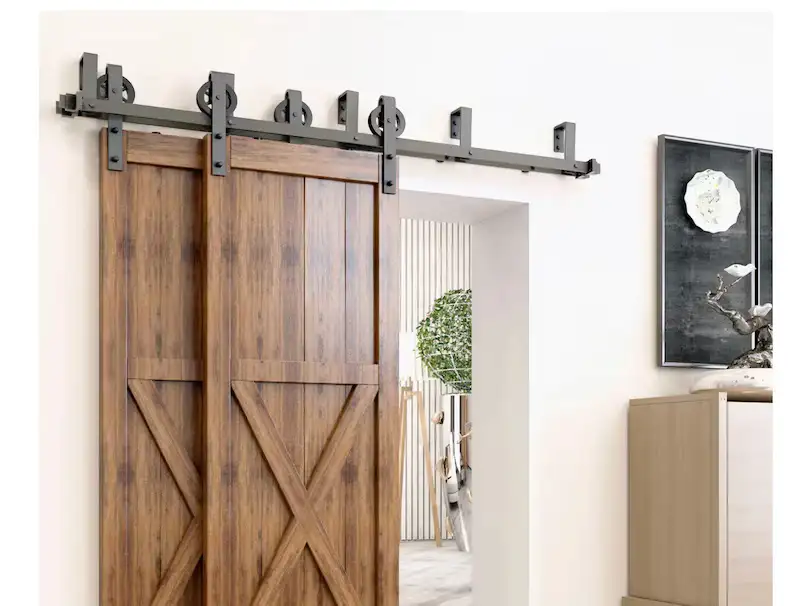
Bypass sliding doors are a type of sliding door that consists of two or more panels that slide past each other, creating a partition between spaces. This design makes bypass sliding doors a functional option for small bathrooms.
PROS:
- Space-saving: Bypass sliding doors can be installed in a smaller space than traditional sliding doors, making them ideal for small bathrooms.
- Versatile: Bypass sliding doors can be used as a divider between spaces or as an entrance or exit.
- Customizable: Bypass sliding doors are available in a range of materials and designs, making them a versatile option for small bathrooms.
CONS:
- Less private: Bypass sliding doors do not provide the same level of privacy as other types of sliding doors, as they do not have a solid panel.
- More expensive: Bypass sliding doors are generally more expensive than pocket doors due to their more complex design.
III. Materials Used For Sliding Door
When it comes to choosing the right sliding door for your bathroom, the material it’s made of plays a crucial role in determining its functionality, aesthetic appeal, and longevity. In this section, we’ll delve into three common materials used for sliding doors—wood, glass, and metal—and explore their pros and cons, as well as some stylish solutions to consider.
A. Wood
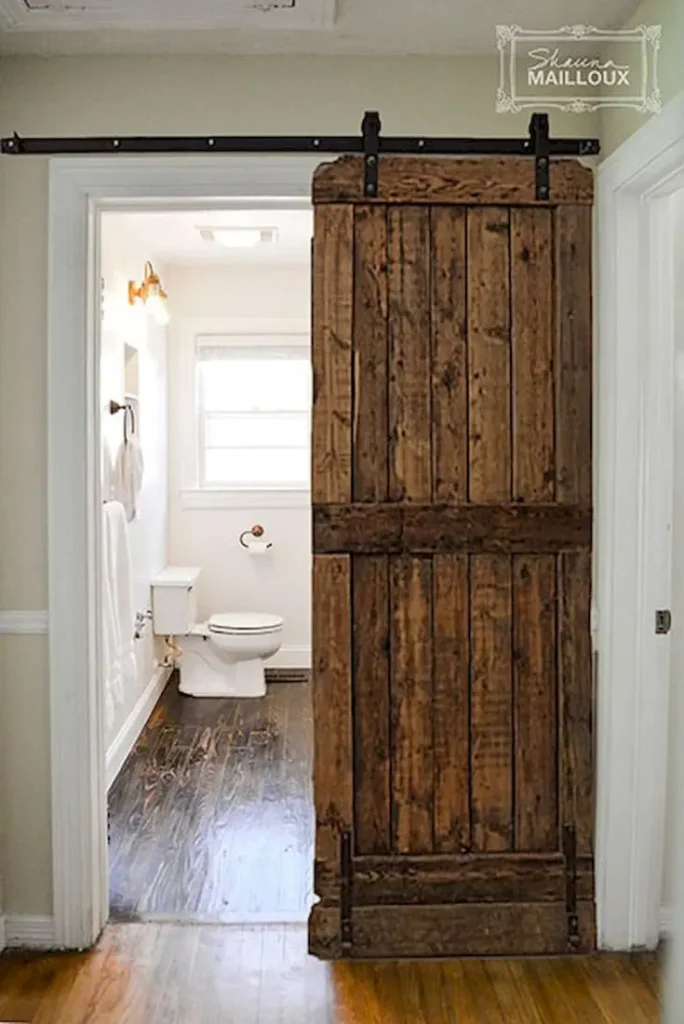
Wooden sliding doors exude warmth and classic elegance, making them a popular choice for many homeowners. However, they do require regular maintenance to ensure they remain in good condition, especially in moisture-prone bathrooms. To mitigate this risk, opt for water-resistant species like teak or cedar, which are naturally resistant to rot and decay. Teak, in particular, is a popular choice for bathroom doors due to its durability and resistance to warping.
B. Glass
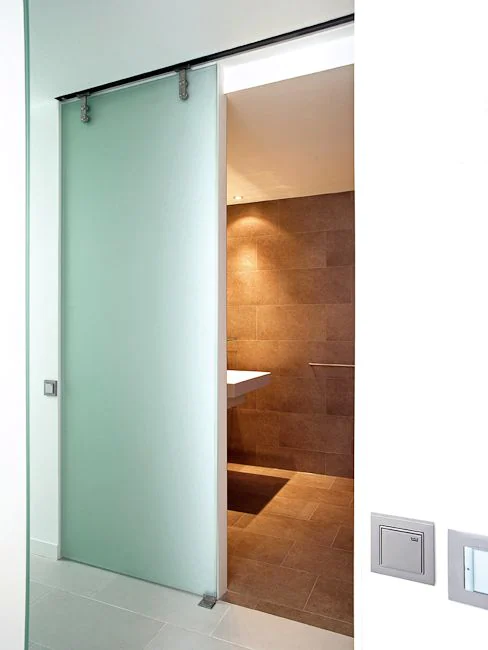
Glass sliding doors are a chic and modern alternative to traditional wooden doors. They allow natural light to flood the bathroom, creating a bright and airy ambiance. However, one downside to glass doors is that they may not offer complete privacy, especially if you live in a multi-family dwelling or have neighbors nearby. To address this concern, consider frosted or textured glass, which provides a stylish solution while still allowing natural light to filter in. Frosted glass, in particular, has a matte finish that obscures visibility while still permitting light to pass through.
C. Metal
Metal sliding doors are a sleek and durable option that can add an industrial touch to your bathroom. They are easy to clean and maintain, making them a practical choice for busy households. However, metal doors can feel cold and industrial, which may not be suitable for all bathroom styles. To combat this, opt for coated or painted options that offer a warmer feel. For instance, a powder-coated metal door in a soft gray or white shade can bring a touch of sophistication to your bathroom while still providing the durability you need.
IV: Installation Process for Sliding Doors
The installation process for sliding doors is a straightforward task that can be completed with a few basic tools and some careful planning. Here’s a step-by-step guide to help you get started:
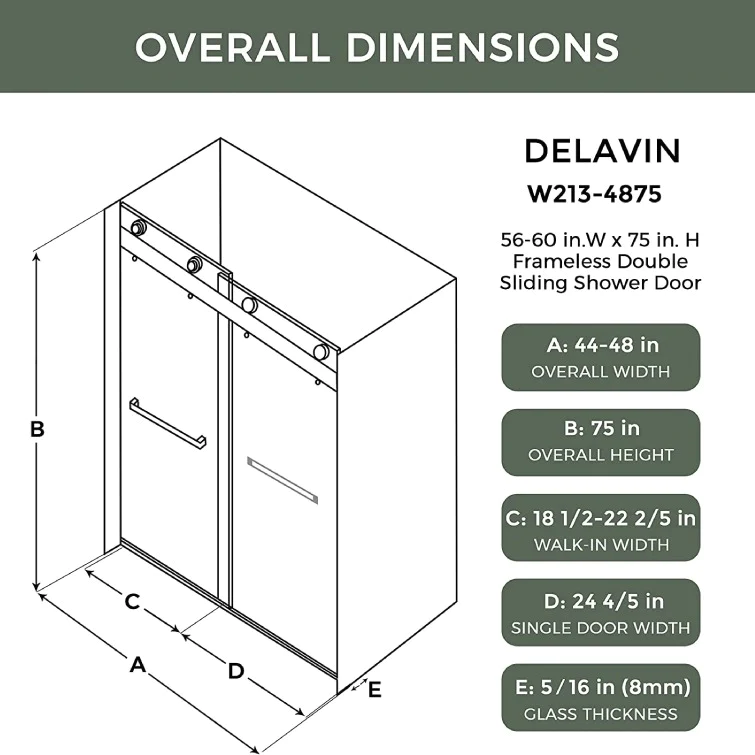
A. Preparing the Site and Removing Any Obstacles
Before you begin installing your sliding door, make sure the area is clear of any obstructions and debris. Remove any old doors, door frames, or other objects that could interfere with the installation process. It’s also essential to check the level of the floor and ensure that it’s stable enough to support the weight of the door. If necessary, make any necessary repairs or adjustments to the subfloor before proceeding.
B. Assembling and Installing the Door Frame
Once the site is prepared, it’s time to assemble and install the door frame. Start by unpacking the frame components and following the manufacturer’s instructions to assemble the frame. Typically, this involves attaching the side jambs to the head jamb using screws or nails. Once the frame is assembled, install it in the doorway, making sure it’s square and plumb. Secure the frame to the surrounding walls using anchors or screws.
C. Installing the Door Panels and Hardware
With the frame in place, it’s time to install the door panels and hardware. Begin by attaching the rollers or tracks to the bottom of the door panels, following the manufacturer’s instructions. Next, hang the door panels on the rollers or tracks, making sure they’re properly aligned and securely attached. Finally, install the door handles, locks, or other hardware according to the manufacturer’s instructions.
D. Testing and Adjusting the Door for Smooth Operation
Once the door is fully installed, test it to ensure it operates smoothly and efficiently. Check that the door glides effortlessly along the tracks or rollers without any sticking or jamming. If necessary, make adjustments to the rollers or tracks to improve the door’s movement. Also, ensure that the door is properly sealed and insulated to prevent drafts and minimize noise.
By following these steps, you’ll be able to successfully install your sliding door and enjoy the benefits of a modern, stylish, and functional entryway. Remember to always follow safety guidelines during the installation process and consult professional assistance if needed.
V. Maintenance and Upkeep of Sliding Doors
Your stunning new sliding door has transformed your bathroom, but the journey doesn’t end there. Just like any other hero, your door needs regular maintenance to keep it functioning flawlessly and looking its best. Let’s explore the secrets to keeping your sliding door the champion of your bathroom:
A. Regular Cleaning And Lubrication
Just like your car needs regular oil changes, your sliding door thrives on a cleaning and lubrication routine. Here’s the winning formula:
- Clean the door panels and track them regularly: Use a mild soap solution and a soft cloth to wipe down the door panels. Don’t forget the track! Remove any dirt, dust, or debris that might hinder smooth operation.
- Lubricate the rollers and track: Every few months, apply a lubricant specifically designed for sliding door tracks. This reduces friction and ensures effortless gliding. Follow the manufacturer’s instructions for the type of lubricant and application points.
Bonus Tip: For glass doors, use a non-streaking glass cleaner to avoid stubborn watermarks and maintain a sparkling shine.
B. Addressing Any Issues Promptly
Don’t wait for a minor issue to snowball into a major headache! Be proactive and address any problems promptly.
- Sticking or uneven movement: This could be due to dirt buildup, misaligned rollers, or a damaged track. Identify the source and rectify it using lubrication, adjustments, or professional repair depending on the severity.
- Loose screws or hardware: Tighten any loose screws or hardware to ensure the door remains secure and stable.
- Damaged door panels or track: If you notice cracks, chips, or warping, address them promptly to prevent further damage and maintain the door’s integrity.
C. Periodic Inspection And Repair
Think of this as your door’s yearly checkup! Once or twice a year, give your door a thorough inspection:
- Check the track and rollers for wear and tear. Replace damaged elements to ensure smooth operation.
- Inspect the door panels for cracks, chips, or water damage. Address any issues promptly.
- Test the door’s alignment and adjust if necessary.
By making maintenance and upkeep a regular practice, you’ll ensure your sliding door performs flawlessly for years to come. Remember, prevention is key to avoiding costly repairs and ensuring your bathroom hero continues to slide with grace and ease.
Remember: Don’t hesitate to seek professional help for complex repairs or if you’re unsure about tackling an issue yourself. A qualified technician can diagnose and fix problems efficiently, saving you time and ensuring your door’s longevity.
With a little TLC and proactive care, your sliding door will continue to be a source of beauty and functionality in your bathroom, creating a haven of sliding bliss for years to come!
VI: Tips and Advice On How To Choose The Right Door
A. How to Measure the Space Correctly
Measuring the space correctly is crucial to ensuring your new sliding door fits perfectly and functions smoothly.
- Take precise measurements: Use a tape measure to take accurate measurements of the width and height of the door opening. Be sure to measure from the edge of the door frame to the opposite edge, and from the top of the door frame to the bottom.
- Consider the thickness of the door: When measuring the width, factor in the thickness of the door panels. Most sliding doors are around 1 3/8 inches thick, so be sure to subtract that amount from the measurement.
- Account for obstructions: If there are any obstructions in the doorway, such as a structural beam or a large piece of furniture, be sure to account for them when taking your measurements. You want to make sure the door has enough clearance to open and close smoothly.
- Measure twice, order once: Double-check your measurements before placing your order. It’s better to be safe than sorry!
B. How to Choose the Right Type of Door
Choosing the right type of sliding door can be overwhelming, but here are some factors to consider to help you make the right decision:
- Style: Think about the style of your home and the room where the door will be installed. Modern, contemporary, or traditional—there are plenty of options to choose from.
- Material: Consider the materials used in the construction of the door. Vinyl, aluminum, and wood are popular choices, each with its own set of benefits.
- Functionality: Think about how you want the door to function. Do you want a manual or motorized door? Do you want a single-door or double-door setup?
- Budget: Let’s face it – budget is a big consideration. Set a realistic budget and stick to it to ensure you get a door that meets your needs without breaking the bank.
C. Common Issues and How to Troubleshoot Them
Even the best-made sliding doors can encounter issues from time to time.
- Stuck doors: If your door gets stuck, it’s usually due to misaligned tracks or dirty rollers. Try cleaning the rollers and tracks, and ensure the door is properly aligned.
- Squeaky doors: Squeaky doors are often caused by dry rollers or worn-out bearings. Apply silicone spray or oil to the rollers and bearings to quiet the squeak.
- Rattling doors: Rattling doors are usually a sign of loose screws or bolts. Check the door’s hardware and tighten any loose fasteners.
- Off-track doors: If your door comes off the track, it’s likely due to a broken or damaged roller or track. Replace the damaged component and reinstall the door.
By following these tips and advice, you’ll be well on your way to selecting and installing the perfect sliding door for your home.
VII. DIY Delight: Build Your Own Barn Door (Optional)
Are you a DIY enthusiast looking to add a personal touch to your bathroom? Look no further! Building your rustic barn door is a fun and rewarding project that can be accomplished with a few simple tools and materials. And the best part? You can customize it to fit your unique style and space.
Now I get what you’re thinking: “Building a barn door sounds like a lot of work!” But believe me, it’s easier than you think. With a little bit of patience and some basic carpentry skills, you can create a beautiful and functional door that will be the envy of all your friends.
Here’s a step-by-step tutorial on how to build your rustic barn door:
Step 1: Gather Your Materials
2x4s or 2x6s for the frame
Plywood or MDF for the door panel
Wood trim for the edges
Hinges and screws
Wood stain or paint (optional)
A drill, a saw, and other basic carpentry tools
Step 2: Build the Frame
Use your 2x4s or 2x6s to create the frame for your door. You can use a simple rectangle shape or get creative with a more intricate design. Make sure the frame is sturdy and can support the weight of the door.
Step 3: Create the Door Panel
Cut your plywood or MDF to size and attach it to the frame. You can use screws or nails to secure it in place. Make sure the panel is flush with the frame to ensure a smooth closure.
Step 4: Add the Trim
Use wood trim to cover the edges of the door panel. This will give your door a finished look and help protect the edges from wear and tear.
Step 5: Attach the Hinges
Attach the hinges to the frame and the door panel. Make sure they are securely attached and can support the weight of the door.
Step 6: Add the Finishing Touches
Sand down any rough edges or splinters to ensure a smooth surface. You can also stain or paint the door to match your bathroom’s decor.
And that’s it! You now have a beautiful, functional barn door that adds a touch of rustic charm to your bathroom. Plus, you can brag to your friends about how you built it yourself.
VIII. Addressing Potential Drawbacks and Challenges
A. Weight and size of the doors
Those sleek glass panels or rustic barn doors might look stunning, but remember that size and weight matter. Here’s how to navigate this hurdle:
How to properly measure and choose the right size door?
Don’t underestimate the power of the measuring tape! Carefully measure your doorway’s width, height, and available wall space for the track. Remember, factor in the door’s swing radius to avoid awkward encounters with your shower curtain.
Tips for handling and installing heavy doors
Opt for a door size that fits comfortably within your space. While larger doors offer a grander feel, they might be impractical for smaller bathrooms. Consider the weight when choosing materials. Glass might look amazing, but it can be hefty to handle.
Bonus Tip: For heavy doors, explore bypass options where each panel slides independently, reducing the weight you need to manage at once.
B. Need for proper installation and maintenance
Let’s face it, some of us were born with screwdrivers in our hands, while others find power tools intimidating. So, how do you decide whether to DIY or call in the pros for installation?
The importance of hiring a professional for installation
For complex door types, intricate tracks, or if your DIY skills are more theoretical than practical, hiring a professional installer is the way to go. They have the expertise and tools to ensure a smooth, safe, and long-lasting installation.
DIY installation options and tips
If you’re handy and enjoy a challenge, some sliding door types, like barn doors, offer DIY-friendly options. Just be sure to choose a beginner-friendly design, gather the necessary tools and materials, and follow the detailed instructions carefully. Remember, safety first!
C. Other potential drawbacks and challenges
While space-saving and stylish, sliding doors have a few other aspects to consider:
Cost compared to traditional doors
Sliding doors can be more expensive than traditional hinged doors, depending on the material and hardware chosen. Factor in installation costs as well if you’re not tackling it yourself.
Limited visibility and security
Some sliding doors, like frosted glass or bi-fold options, offer less visibility and privacy compared to solid doors. If security is a concern, consider additional measures like locks or frosted glass only on the upper portion of the door.
Remember: Every bathroom is unique, and the challenges you face will depend on your specific needs and preferences. By weighing the pros and cons, carefully considering these potential drawbacks, and choosing the right type of door for your space, you can transform your bathroom into a haven of functionality and style, with minimal bumps along the way!
With this knowledge in hand, you’re well-equipped to navigate the challenges and embrace the magic of sliding doors. So, slide on into your bathroom renovation journey with confidence, knowing you’ve considered all the angles!
IX: A Recap Of Small-Space Bathroom Sliding Door Key Points
Small bathrooms rejoice! Sliding doors offer a stylish and space-saving solution, transforming cramped quarters into functional and airy havens.
Key benefits:
- Maximize space: Eliminate the swing radius of traditional doors, creating more usable space.
- Boost style: From sleek glass to rustic barn doors, choose a style that complements your bathroom’s aesthetic.
- Enhance privacy: Opt for frosted glass or textured panels for desired levels of privacy.
- Improve ventilation: Certain door configurations, like bypass doors, promote better air circulation.
Choosing your champion:
- Consider space availability, privacy needs, style preference, and budget when selecting your door type.
- Popular options include pocket doors, bi-fold doors, barn doors, and bypass doors.
- Materials like wood, glass, and metal each offer unique advantages and require different levels of maintenance.
Installation and beyond:
- Professional installation is recommended for complex designs or if DIY isn’t your forte.
- Regular cleaning and lubrication ensure smooth operation and longevity.
- Address minor issues promptly to prevent bigger problems down the line.
Challenges and considerations:
- The weight and size of the door should be compatible with your space and doorway.
- Installation complexity might require professional help.
- Cost can be higher than traditional doors depending on material and hardware.
- Limited visibility and security might be concerns for some layouts.
By carefully considering these points and choosing the right door for your needs, you can unlock the magic of sliding doors and transform your small bathroom into a space-efficient and stylish oasis. Happy sliding!
